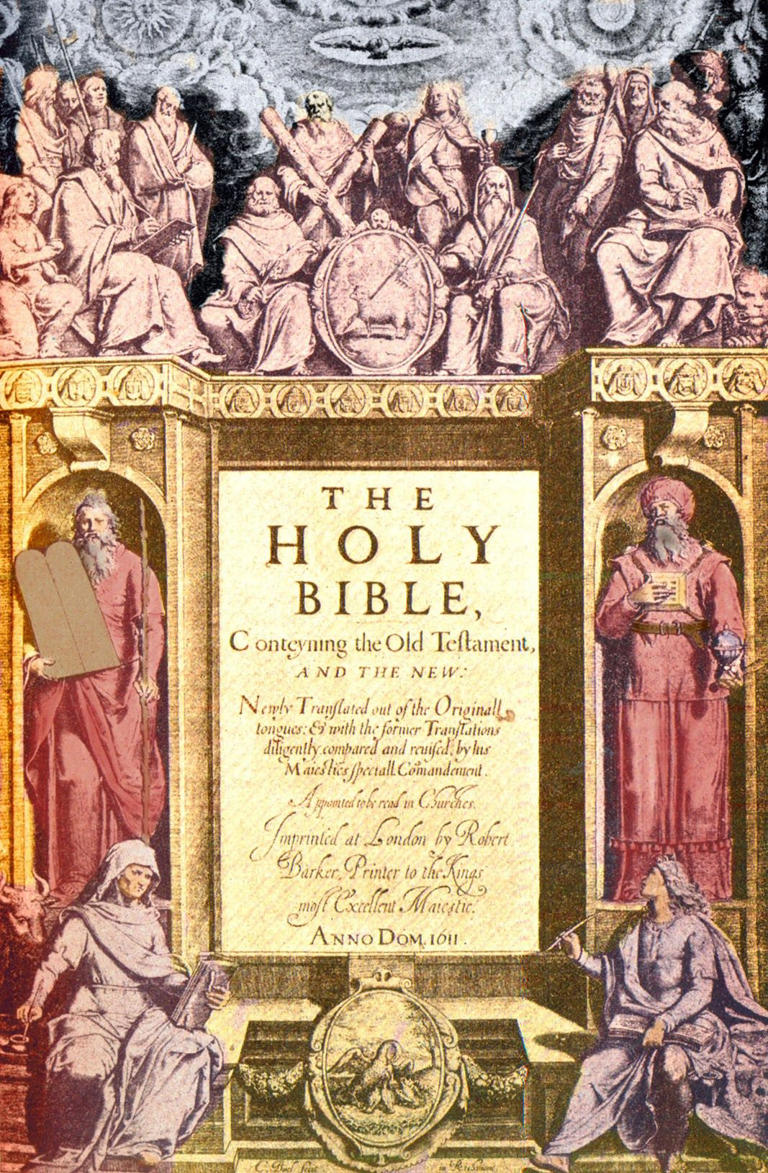Sodomy and theology: the feverish birth of the King James Bible










Sodomy and theology: the feverish birth of the King James Bible
In 1611, the new English translation of the Bible was completed. Authorised by King James I, it was subsequently installed with his blessing in every Anglican church. Known variably as the King James Bible, the King James Version or the Authorised Translation, it is, by any standards, a work of sombre beauty. Its influences – artistic and spiritual – continue to be felt four centuries later, when a quarter of a million copies are still sold annually by Oxford University Press alone. The KJV’s 17th-century translators rendered into English innumerable phrases that have since become commonplace, from “a brother’s keeper” in Genesis to Christ’s metaphor, in the Gospel of Luke, of “old wine in new bottles”.
The King James Bible’s journey began seven years prior, at Hampton Court. In January 1604, the palace had just finished hosting the celebrations for the Stuart dynasty’s first Christmas in England. Piety had not been high on the list of celebrated virtues. During the festivities, the French and Spanish ambassadors had nearly come to blows over who would have the honour of dancing with the Prince of Wales. Drunken aristocrats had passed out in the Great Watching Chamber, taking a refreshments table down as they went.
Next door, in the palace’s magnificent Great Hall, King James I’s latest favourite – the handsome but stupid Lord Philip Herbert – had struggled to execute his choreographed dance during the Christmas masque because his costume was so heavy with jewels that he nearly toppled over. Herbert, like most of his fellow courtiers, was nursing a hangover of week-destroying proportions by the time Christmas ended, and the workmen were sent in to repair the damage inflicted by revellers on the palace floors.
The 37-year-old James I – or James VI, as he remained in Scotland, where he had been King since infancy – was made of sturdier stuff. He handled alcohol well and parliaments poorly. Tall and thin with ginger hair, an inability to sit still and a filthy sense of humour, James had succeeded to the English and Irish thrones the previous March on the death of his childless kinswoman and godmother, Elizabeth I. Gloriana had left him three poisonous inheritances: the first was the nostalgia for her, which James could neither live up to, nor exorcise; the second was a tottering economy, no more her fault than his, but inflicted by six consecutive terrible summers that had felled harvests and raised food prices; the third was a creaking Church of England, tolerated by most and loved by none.
Upon James’s arrival in England, he had received the Millenary Petition from the Puritan wing of the Church, who begged him to reform it into a more purely Protestant version of itself. This was countered by the High Anglican wing – to use a more modern term – who were led by the fine-living John Whitgift, Archbishop of Canterbury.
His success in thwarting the Puritan faction earned him a place in their propaganda tracts, in which they tried to destroy Whitgift with the accusation that he was having a homosexual affair with the vice-chancellor of the University of Cambridge.
Central to the two factions’ disagreements was their use of two competing translations of the Bible. The Puritans tended to prefer the Geneva Bible, translated in Switzerland during the 1550s by English Protestant refugees who had fled the persecutions inflicted by Mary I and brought back with them after her death. In contrast, the preferred text of the High Anglican congregations was the Bishops’ Bible, approved in 1568 by Elizabeth.
In that spring of 1604, while the rest of his courtiers and favourites sweated through their post-Yuletide hangovers, James invited representatives of both theological wings to Hampton Court for a conference. With his passion for theology, and his particular enthusiasm for the divine right of kings, James saw this conference as a resurrection of the ancient Christian ecclesiastical councils, chaired by Roman emperors, with himself as a latter-day Constantine the Great.
Whitgift arrived to charm the King into maintaining the Church’s hierarchy of bishops, while the 68-year-old Puritan Dr Laurence Chaderton, a former wrestler who had become Master of Emmanuel College, Cambridge, descended on Hampton Court with his fellow dons, bent on securing the abolition of bishoprics, a stricter enforcement of the Sabbath, and the outlawing of clerical vestments because they (supposedly) smacked of paganism.
The issue of the Bible was one of the few things on which these feuding clerics could agree. As the delegates later put it, at Hampton Court they reached the conclusion that the two competing Bibles must be laid to one side for the good of English Christian unity – and that, to that end, “there should be one more exact Translation of the Holy Scriptures into the English tongue”.
Nearly everything else discussed at Hampton Court was a failure. The King took great dislike to the Puritans, referring to them as “an infestation in the bowels of the nation”, and seeing their attack on the bishops as a prelude to a similar assault on the monarchy. “No bishop, no king!” he allegedly shouted during one round of negotiations, then stormed out of his Presence Chamber.
The commission for a new English translation of the Bible, however, showed James I at his best. The Bible was split into six sections, each of which was then assigned to one of six committees: two at Westminster, two at Oxford and two at Cambridge, with relevant experts appointed to each committee based on their previous fields of research.
Over the next seven years, these pious men laboured at their task, encouraged and sometimes chivvied by the King. The potential pitfalls of translation tormented the translators. They worked with the fearful inspiration that an error on their part could take the millions of Christians reading this Bible one step farther away from God. Entire lives have been lived, ended, brutalised or uplifted based on how a single sentence in the Bible was interpreted.
The High Anglican wing, for instance, scored a victory over the anti-episcopal Puritans when they had the word “episkopois” translated into English as “bishop” rather than “overseer”. For James I, their dealings with the word “sodomy” had a personal element. In public, the King described it as a sin which “ye are bound in conscience never to forgive”; in private, he exchanged letters to a male favourite in which he discussed pinning his knees to his chest.
Furthermore, when he used the word “sodomy”, James may have meant homosexual intercourse – whether his own relationships were strictly platonic or not – but theologians debated whether sodomy could instead mean blasphemy (being an attempted assault on the Divine), or bestiality, or indeed any form of intercourse through which pregnancy was impossible.
The choices made by these translators have shaped the English language today. Some, like the Gospel of Matthew’s “baptism of fire” or the Psalms’ “biting the dust”, have endured as paraphrases from the KJV’s precise wording. Others, in contrast, entered the English language unedited in the years after 1611: phrases such as the prophet Job surviving “by the skin of his teeth”, St Paul’s “labours of love”, Christ’s “casting pearls before swine”, Ecclesiastes’s “dead flies in the ointment” and the Psalmist’s people “at their wits’ end”.
Its spiritual vocabulary, too, continues to ring out at ceremonies marking the milestones of many Christians’ lives. Among the most beautiful, I think, is the KJV’s choice of the words “still small voice of calm” to describe the revelation heard by the prophet Elijah – a still small voice of calm that emerged from the political quarrels of the 1600s, and the hubbub of a hungover Hampton Court.
Articles-Latest
- St George’s Day 2024: Date, meaning and who England’s patron saint was
- 18 Everyday Things Amish Women Aren’t Allowed to Do
- Russian priest who led Alexei Navalny’s memorial service mysteriously suspended by Moscow church
- United Methodists open first top-level conference since breakup over LGBTQ inclusion
- Former archbishop George Carey backs assisted dying campaign after 'conversion'
- Using Vibrational Aromatherapy In Treatment - 2
- Taliban step up security ahead of supreme leader’s Kandahar mosque visit on Eid
- Using Vibrational Aromatherapy In Treatment
- The BI-Gendered God-She-male Gods & The Roots of Christianity
- Geometry and Myth-She-Male Gods & the Roots of Christianity
- Muslim Council Demands Investigation Into Islamophobia in the Conservative Party
- What does the Bible say about homosexuality? Well, for starters, Jesus wasn’t a homophobe
- King Charles attends Easter service, providing a glimpse of the monarch after cancer diagnosis
- We must stand up to religious extremism in the UK before it tears us apart,’ writes Frederick Chedam
- Trump compares himself to Jesus Christ – again
- Pope makes last-minute decision not to deliver Palm Sunday Mass homily
- New York City's mayor gets baptized in jail by Rev. Al Sharpton on Good Friday
- Pope Francis calls predecessor Benedict a key transitional figure
- Lawyers hit out at Vatican’s ‘trial of the century’ after Pope secretly changes law four times
- What we know about the killing of Detroit synagogue leader Samatha Woll
Articles-Most Read
- Home
- Let There Be Light
- Plants that feel and Speak
- The Singing Forest
- The Singing Forest-2
- Introduction
- Meditation
- Using Essential Oils for Spiritual Connection
- Heaven Scent
- Plants that Feel and Speak-2
- Purification
- Making the Spiritual Connection
- Anointing
- The Sanctity of Plants
- Essential Oils: The unseen Energies
- The Aroma Of Worship - Introduction
- The Aroma Of Worship-Foreward
- Methods Of Use
- Spiritual Blending
- Handling and Storage









